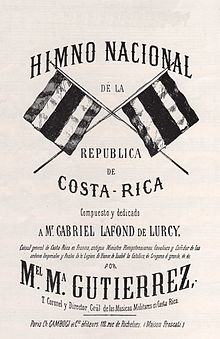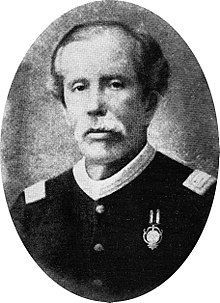National anthem of Costa Rica
| English: Costa Rican National Anthem | |
|---|---|
 Cover of the first edition of the national anthem, 1864 | |
National anthem of | |
| Also known as | Noble patria, tu hermosa bandera (English: Noble fatherland, your beautiful flag) |
| Lyrics | José María Zeledón Brenes, 1903 |
| Music | Manuel María Gutiérrez Flores |
| Adopted | 1852 |
| Audio sample | |
U.S. Navy Band instrumental version | |
The National Anthem of the Republic of Costa Rica (Spanish: Himno Nacional de la República de Costa Rica), also known by its incipit as "Noble patria, tu hermosa bandera" ("Noble Fatherland, Your Beautiful Flag"), was first adopted in 1852. Its music was composed by Manuel María Gutiérrez Flores, who dedicated the score to French adventurer Gabriel-Pierre Lafond de Lurcy. The music was created to receive delegates from the United Kingdom and the United States that year for the Webster-Crampton Treaty. It was the first Central American national anthem.[1]
The anthem has had several lyrics; the current lyrics were written for a contest held in 1903 by the government of Ascensión Esquivel Ibarra to give the anthem lyrics that reflected the idea of being Costa Rican. The contest was won by José María Zeledón Brenes.
The anthem's lyrics were made official in 1949 by the Founding Junta of the Second Republic, led by José Figueres Ferrer. The music was made official in 1979, under President Rodrigo Carazo Odio.
History
[edit]From the period of independence within the First Mexican Empire from 1821 to the beginning of the First Costa Rican Republic in 1848, Costa Rica did not have a national anthem. After the establishment of the republic, Costa Rica began to gain more recognition from other nations. In 1852, then president, Juan Rafael Mora Porras, learnt of the arrival of diplomatic representatives from the United Kingdom and United States in order to establish embassies.[2]

Musician and Director of the Costa Rican Military Band, Manuel María Gutiérrez, then 22 years old, was asked to compose an anthem. Professing a lack of experience and little time, Gutiérrez asked for help from French adventurer Gabriel-Pierre Lafond de Lurcy, who instructed and encouraged him. After consulting Lafond, Gutiérrez composed the anthem in three or four days in his home in central San José. An apocryphal story circulates that Gutiérrez had to compose the music for the anthem while locked in a prison cell for refusing the order the president gave him to compose the anthem,[1][2] and that he composed the anthem in 24 hours.[2]
The anthem was played in public for the first time by the Banda de San José (San José Band) at the welcome receptions for the delegations from the United Kingdom and United States on 11 June 1852 at the Casa de Gobierno (Government House).[2] The event was held in the Main Barracks, where the Raventós Theatre was later situated, today the Melico Salazar Theatre.
The anthem was largely forgotten after this, so much so that lyrics for it were not made official until 1949, after the civil war and the founding of the Second Republic, and the music was not made official until 1 September 1979, with decree 10471-E,[3] during the presidency of Rodrigo Carazo Odio. The decree was intended to coincide with Gutiérrez's birthday (which is now known to be 3 September).[2]
Lyrics
[edit]There was no intention to add lyrics at the time of the anthem's creation, as it was urgently needed for the welcome ceremonies for the foreign delegations. Some lyrics had been written in 1856 during the Filibuster War, to encourage troops on the battlefield, but they were quickly forgotten.[2]
1873 lyrics
[edit]The first lyrics of the national anthem were written by a Colombian poet living in Costa Rica, José Manuel Lleras, and premiered in 1873. In the context of looming threats by other states to overthrow then president Tomás Guardia Gutiérrez, as well as a threat of the instrumental anthem becoming forgotten by non–military band members, Lleras wrote long lyrics that included high praise of President Guardia, intended to encourage Costa Ricans in the event of war:[2]
| Spanish original[4][5][6][7][8] | English translation |
|---|---|
Coro: |
Chorus: |
Lleras's lyrics were forgotten after the events regarding President Guardia.[2]
1879 lyrics
[edit]In 1879, the anthem began to be sung with shorter lyrics written by seminarian Juan Garita y Guillén, which premiered on 24 June that year at the Colegio Seminario (Seminary College).[2] Garita's lyrics were very simplistic:
| Spanish original[4][5][8] | English translation |
|---|---|
Cantaré de la patria querida |
I will sing of the dear fatherland |
Like Lleras's lyrics, Garita's lyrics also stopped being sung.[2] The Lleras and Garita lyrics were never officially adopted.
1888 lyrics
[edit]In 1888, Spanish pedagogue Juan Fernández Ferraz wrote a poetic third set of lyrics for the national anthem, which were longer than the previous lyrics. After being distributed in schools and colleges, they were sung for longer[2] and were made official:
| Spanish original[4][8] | English translation |
|---|---|
Coro: |
Chorus: |
Current lyrics
[edit]Although Fernández Ferraz's composition had literary merit, its language was somewhat too elevated to take root in the people,[2] in addition to not adapting well to the music of the anthem, and adjustments had to be made to the original score by maestro Gutiérrez. All of this led to a decision to replace Fernández Ferraz's lyrics with new lyrics, for which a public contest was held in 1903. The contest was won by a composition by José María Zeledón Brenes, presented under the pseudonym "El Labrador". Zeledón Brenes was declared the winner on 24 August, and his lyrics were first sung publicly on 15 September.[2]
Zeledón Brenes's lyrics, with minor changes, are the current lyrics of the national anthem of Costa Rica. They were officially adopted on 10 June 1949 by the Founding Junta of the Second Republic with decree number 551:[10]

| Spanish original[2][10][8] | English translation |
|---|---|
¡Noble patria!, tu hermosa bandera |
Noble fatherland! Your beautiful flag |
In Zeledón's original wording, the first stanza read:
| Spanish original[4] | English translation |
|---|---|
Costa Rica tu hermosa bandera |
Costa Rica, your beautiful flag |
And the last:
| Spanish original[4] | English translation |
|---|---|
¡Salve, oh patria!, tu pródigo suelo |
Hail, oh fatherland! Your prodigal soil |
Notes
[edit]References
[edit]- ^ a b "Cuatro letras y profundas variaciones marcaron al Himno Nacional • Semanario Universidad". Semanario Universidad (in Spanish). 2014-09-17. Retrieved 2022-01-12.
- ^ a b c d e f g h i j k l m n Martínez Gutiérrez, Bernal (2016). HIMNOS DE MI PATRIA (PDF). pp. 41–42. ISBN 978-9977-58-446-1. Retrieved 2022-01-12.
{{cite book}}:|website=ignored (help) - ^ "Sistema Costarricense de Información Jurídica". www.pgrweb.go.cr. Retrieved 2022-01-12.
- ^ a b c d e f Amoretti, María (1987). Debajo del canto: un análisis del himno nacional de Costa Rica (in Spanish). Editorial Universidad de Costa Rica. ISBN 978-9977-67-073-7.
- ^ a b Obregón, Clotilde María (2002). Una historia de valor (in Spanish). Editorial Universidad de Costa Rica. p. 74. ISBN 978-9977-67-695-1.
- ^ a b Cruz, Vladimir de la (1988). Historia general de Costa Rica (in Spanish). Euroamericana de Ediciones Costa Rica. pp. 595–596. ISBN 978-9977-975-00-9.
- ^ a b Garnier, José Fabio (1964). La vida de mi patria (in Spanish). Universal.
- ^ a b c d Cullel, María Clara Vargas (2004). De las fanfarrías a las salas de concierto: música en Costa Rica (1840-1940) (in Spanish). Editorial Universidad de Costa Rica. pp. 281–282. ISBN 978-9977-67-802-3.
- ^ a b Lleras, José Manuel (2001). La guarda del campamento: lijero episodio de la Guerra Nacional de Centro-América (in Spanish). Museo Histórico Cultural Juan Santamaría. p. 124. ISBN 978-9977-953-42-7.
- ^ a b "Sistema Costarricense de Información Jurídica". www.pgrweb.go.cr. Retrieved 2022-01-12.
External links
[edit]- Boletín de Cientec sobre los símbolos patrios
- Himno a la Bandera de Costa Rica - MP3 File
- Más que un canto, Documentary the history of the Lyric and music of the himno.
- La Paz - Debajo del Canto, analysis of texts and events that inspired the national anthem.

